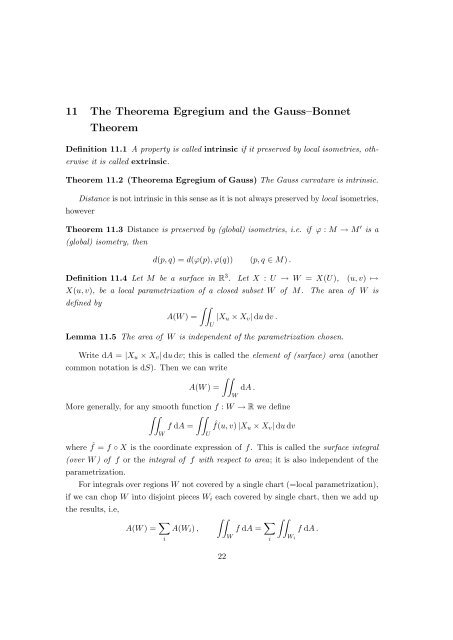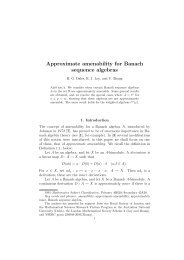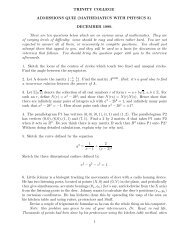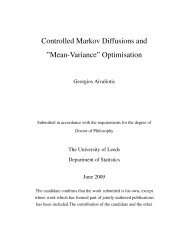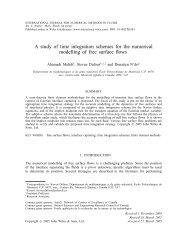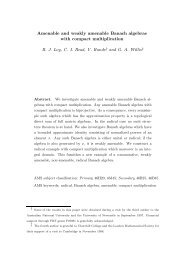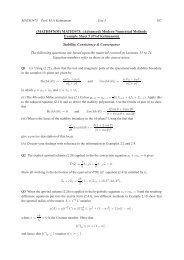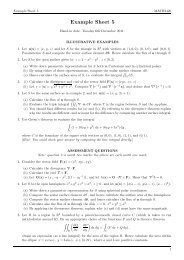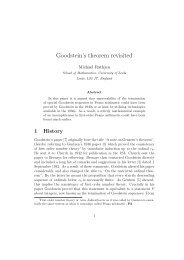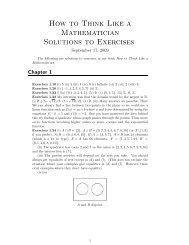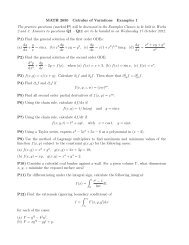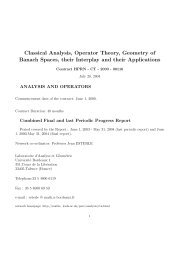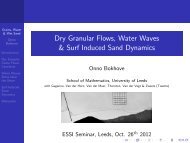11 The Theorema Egregium and the Gauss–Bonnet Theorem
11 The Theorema Egregium and the Gauss–Bonnet Theorem
11 The Theorema Egregium and the Gauss–Bonnet Theorem
Create successful ePaper yourself
Turn your PDF publications into a flip-book with our unique Google optimized e-Paper software.
<strong>11</strong> <strong>The</strong> <strong>The</strong>orema <strong>Egregium</strong> <strong>and</strong> <strong>the</strong> Gauss–Bonnet<br />
<strong>The</strong>orem<br />
Definition <strong>11</strong>.1 A property is called intrinsic if it preserved by local isometries, o<strong>the</strong>rwise<br />
it is called extrinsic.<br />
<strong>The</strong>orem <strong>11</strong>.2 (<strong>The</strong>orema <strong>Egregium</strong> of Gauss) <strong>The</strong> Gauss curvature is intrinsic.<br />
Distance is not intrinsic in this sense as it is not always preserved by local isometries,<br />
however<br />
<strong>The</strong>orem <strong>11</strong>.3 Distance is preserved by (global) isometries, i.e. if ϕ : M → M ′ is a<br />
(global) isometry, <strong>the</strong>n<br />
d(p, q) = d(ϕ(p), ϕ(q)) (p, q ∈ M) .<br />
Definition <strong>11</strong>.4 Let M be a surface in R 3 . Let X : U → W = X(U), (u, v) ↦→<br />
X(u, v), be a local parametrization of a closed subset W of M. <strong>The</strong> area of W is<br />
defined by<br />
∫∫<br />
A(W ) =<br />
U<br />
|X u × X v | du dv .<br />
Lemma <strong>11</strong>.5 <strong>The</strong> area of W is independent of <strong>the</strong> parametrization chosen.<br />
Write dA = |X u × X v | du dv; this is called <strong>the</strong> element of (surface) area (ano<strong>the</strong>r<br />
common notation is dS). <strong>The</strong>n we can write<br />
∫∫<br />
A(W ) =<br />
W<br />
dA .<br />
More generally, for any smooth function f : W → R we define<br />
∫∫ ∫∫<br />
f dA = ˆf(u, v) |X u × X v | du dv<br />
W<br />
U<br />
where ˆf = f ◦ X is <strong>the</strong> coordinate expression of f. This is called <strong>the</strong> surface integral<br />
(over W ) of f or <strong>the</strong> integral of f with respect to area; it is also independent of <strong>the</strong><br />
parametrization.<br />
For integrals over regions W not covered by a single chart (=local parametrization),<br />
if we can chop W into disjoint pieces W i each covered by single chart, <strong>the</strong>n we add up<br />
<strong>the</strong> results, i.e,<br />
A(W ) = ∑ ∫∫<br />
A(W i ) , f dA = ∑ ∫∫<br />
f dA .<br />
i<br />
W<br />
i<br />
W i<br />
22
<strong>The</strong> sums can be shown to be independent of how we chop up W . We can integrate<br />
over <strong>the</strong> whole surface provided it is compact in <strong>the</strong> following sense:<br />
Definition <strong>11</strong>.6 A surface M in R 3 is called compact (or, confusingly, closed) if<br />
(i) it is a closed subset of R 3 in <strong>the</strong> sense of topology, i.e., its complement is an open<br />
subset of R 3 , <strong>and</strong> (ii) it is bounded, i.e., contained in some ball of R 3 .<br />
In particular we can define<br />
Definition <strong>11</strong>.7 <strong>The</strong> total curvature of M is <strong>the</strong> integral of its Gauss curvature<br />
with respect to area:<br />
∫<br />
M<br />
K dA .<br />
We now define a topological invariant of a compact surface.<br />
<strong>The</strong>orem <strong>11</strong>.8 Any compact surface can be triangulated.<br />
Definition <strong>11</strong>.9 <strong>The</strong> Euler characteristic of a compact surface M is<br />
χ(M) = e(M) = F − E + V<br />
where F = <strong>the</strong> number of faces, E = <strong>the</strong> number of edges, <strong>and</strong> V = <strong>the</strong> number of<br />
vertices of some triangulation of M.<br />
<strong>The</strong>orem <strong>11</strong>.10 <strong>The</strong> Euler characteristic of a compact surface M does not depend on<br />
<strong>the</strong> triangulation chosen.<br />
<strong>The</strong>orem <strong>11</strong>.<strong>11</strong> If M <strong>and</strong> M ′ are homeomorphic compact surfaces, <strong>the</strong>n <strong>the</strong>y have<br />
<strong>the</strong> same Euler characteristic.<br />
<strong>The</strong>orem <strong>11</strong>.12 Any compact orientable surface M is homeomorphic to a sphere with<br />
g h<strong>and</strong>les for some g ∈ {0, 1, 2, ...}.<br />
<strong>The</strong> number g is called <strong>the</strong> genus of M.<br />
<strong>The</strong>orem <strong>11</strong>.13 <strong>The</strong> Euler characteristic of a compact orientable surface of genus g<br />
is 2 − 2g.<br />
<strong>The</strong>orem <strong>11</strong>.14 (Gauss–Bonnet) <strong>The</strong> total curvature of a compact surface is 2π<br />
times its Euler characteristic, i.e.,<br />
∫<br />
M<br />
K dA = 2πχ(M) .<br />
23


